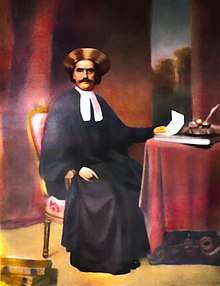Sambhunath Pandit
Sambhunath Pandit (Bengali: শম্ভুনাথ পন্ডিত) (1820-1867) was the first Indian to become judge of Calcutta High Court in 1863. He served in that position from 1863-1867.[1] One of the leading personalities of Kolkata in his age, he had contributed in many ways to the development of legal systems and enrichment of social life.[2]
Sambhunath Pandit শম্ভুনাথ পন্ডিত | |
|---|---|
 | |
| Born | 1820 |
| Died | 6 June 1867 |
| Nationality | Indian |
| Occupation | Judge, social reformer |
Son of Sadasiv Pandit, he belonged to a Kashmiri Pandit family. He was brought up in Bhowanipur, Kolkata. As a child, he went to Lucknow to study Urdu and Persian. On return to Kolkata, he joined the Oriental Seminary.[2]
Active life
In 1861, he joined Dewani Adalat as assistant record keeper. Having acquired experience in law matters he was posted as a court clerk issuing decrees. He wrote a book about the faults in the system of issuing decrees and attracted the attention of the government. The laws were modified with his assistance. He qualified as a lawyer in 1848 and started practising as a criminal lawyer. He taught law at Presidency College and became a senior government counsel. When the high court was established at Kolkata, he became the first Indian to be a judge of the high court.[3] He used to contribute articles on law matters in the Hindu Patriot, then being edited by Harish Chandra Mukherjee.[2]
He was a founder member of British Indian Association. When Bethune School was established in 1849, he admitted his daughter in the institution.[2]
Bhowanipur Brahmo Samaj
In the History of the Brahmo Samaj, Sivanath Sastri writes, "In the month of June 1852, a number of influential men of that suburban town (meaning Bhowanipur) assembled at the house of the late Sambhunath Pandit, latterly a Judge of Calcutta High Court, and established an Association under the name of Jnan Prakasika Sabha, or "Truth Revealing Society", whose object it was to promote the spiritual enlightenment of its members. It was virtually a Brahmo Samaj, though the name was different. Sambhunath Pandit became its president, Babu Annadaprasad Banerjee, a pleader of the High Court, vice-president, and Baboo Harishchandra Mukherji of the Hindu Patriot fame its secretary… From the first anniversary of the Society held in 1853, it was duly and formally installed as Bhowanipur Brahmo Samaj." It followed the Adi Samaj form of divine service.[4]
He published a book entitled On the Being of God.[2]
A government hospital [5] and an important road in Bhowanipur are named after him.
References
- Cotton, H.E.A., Calcutta Old and New, 1909/1980, p576, General Printers and Publishers Pvt. Ltd.
- Sengupta, Subodh Chandra and Bose, Anjali (editors), 1976/1998, Sansad Bangali Charitabhidhan (Biographical dictionary) Vol I, (in Bengali), p508, ISBN 81-85626-65-0
- According to Gopa Sabharwal, "1861 - British Parliament enacts the Indian High Courts Act, abolishes the old Sadr Adalat (courts generally inherited by the Company from their native predecessors) and sets up new High Courts of Judicature in Calcutta, Madras and Bombay." The Indian Millennium 1000-2001, 200/2002, p379, Penguin Books.
- Sastri, Sivanath, History of the Brahmo Samaj, 1911-12/1993, pp378-379, Sadharan Brahmo Samaj, 211 Bidhan Sarani, Kolkata.
- In his Civic and Public Services in Old Calcutta, P. Thankappan Nair writes, "The Government had also started a public dispensary in Bhabanipur in 1840. In 1896, it was moved to a commodious new building (provided by the Corporation) and renamed the South Suburban Hospital. In 1898, it became Shambhunath Pandit Hospital after the first Indian judge at the Calcutta High Court. Calcutta: The Living City, Volume I, edited by Sukanta Chaudhuri, p229, Oxford University Press, ISBN 0-19-563696-1.